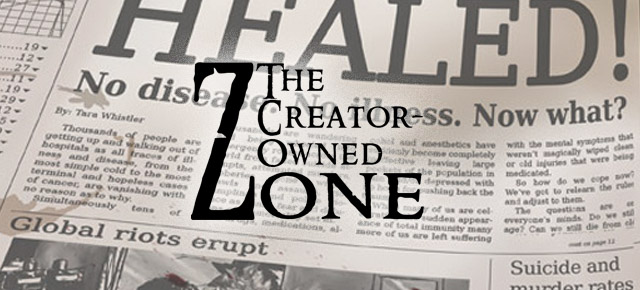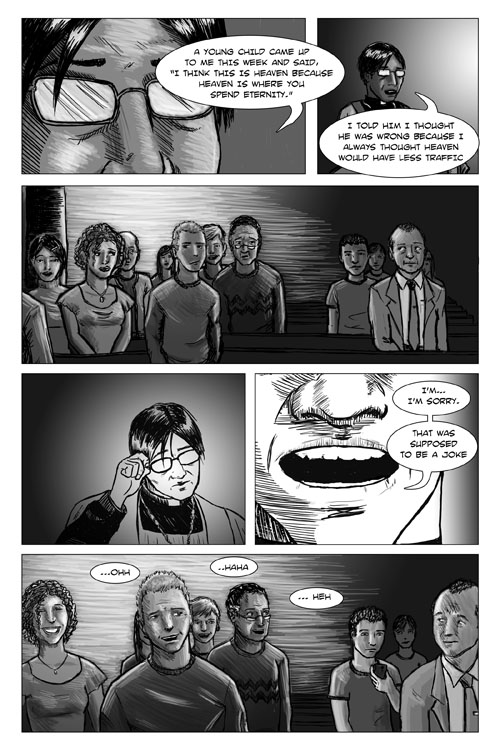Review: Healed #1
 No disease. No illness. Now what?
No disease. No illness. Now what?
Here is a case of a comic boldly declaring its own elevator pitch on its front cover, in the eye-catching form of a newspaper headline. It’s a tantalising high concept that writer George O’Connor has come up with: what if one day everybody in the world stopped dying of natural causes? People with terminal illnesses would be miraculously cured, we could theoretically live forever, and while that might sound great at first, O’Connor demonstrates the various ways this could be quite disastrous for the world. Rioting, mass suicides, hysteria, and all medications, drugs and even alcohol have stopped having any effect. O’ Connor has created a world rife with narrative possibility, capable of supporting many different kinds of story. O’Connor makes the most of that by presenting Healed in an episodic format, with the issue containing three self-contained vignettes, giving us insight into various aspects of the larger tapestry, rather than limiting our perspective to one set of characters.
Generally, each of these stories does a good job of painting a picture of this strange new world. The first episode, Forever After , deals with the spiritual implications of living forever, with a priest conducting a difficult church service before a reduced congregation. Given that this is the first story, there is a good deal of world-building and exposition in this first story, but it is handled with a light enough tough to not feel intrusive. I liked the characterisation in this first story, and the poignant human response to such a reality-altering event. However, I fear O’Connor spoiled it a little in the end with an unnecessary sting in the tail, with the climactic shock certainly making a bigger immediate impact for an ending, but failing to provide the deeper resonance that the story seemed to promise up until that point.
The second episode, Restructuring, has a marked shift in tone, leaning more towards the darkly humorous. This demonstrates O’Connor’s versatility, and the diversity of potential narratives to be explored in this universe he’s created. Here, we follow a bad day in the life of Donna Gibbs, president of a pharmaceutical company. Given the state of the world, she has gone from being a very influential figure to having her stock quickly fall into oblivion, and as a result she’s selfishly concerned with her impending demotion than any of the larger problems affecting the world. In this tale, we learn what many conspiracy theorists have long suspected: the drug companies had the cure for cancer all along, but there’s more money in treating the symptoms than curing the disease. Only now there is no need for them to do either.
One Minute More, the third and final episode of the first issue, is probably the best of the bunch. In comparison to the other two stories, we get little in the way of exposition, instead focusing in on the heartbreak of one individual tangentially affected by the healing. Most of the story is an extended silent sequence, really helping to generate an understated emotional response. O’Connor expertly sets up an expectation of where the story is going, making the climax all the more painful. In all three episodes, but this one in particular, O’Connor displays sound storytelling craft, utilising a clever central concept in various effective ways.
It’s unfortunate then that, though the writing is quite strong, the visual elements of the comic often let it down. Artist S. Griffin’s rough, almost charcoal-like style just doesn’t mesh well with the story. His facial expressions are often awkward and unconvincing, while his anatomy is all over the place. With their often cartoonish body shapes, characters sometimes look more like Celebrity Death Match putty figures than real human beings. It’s not a style that’s necessarily bad, but with a comic such as Healed, where the narrative is based heavily on human drama, and consequently so much depends on the intricacies of facial expressions and body language, it really detracts from much of the emotional punch Healed could have packed.
Also, I seem to find myself saying this a lot in my reviews, but this comic could really have benefitted from the touch of an expert letterer. We have misshapen bubbles, extra segments squeezed in to fit in extra words, awkward layouts and placements, and problems with something as seemingly simple but omnipresent as the way the bubble borders the words inside it. Again, it’s the kind of thing you don’t notice in a comic when it’s done right, but when handled incorrectly it is often a quick indicator that makes indie comics look amateur and comics from big publishers look professional .
Though the visuals hurt it, George O’Connor’s story remains strong, driven by a great high concept. This concept – What if people stopped dying? – is being exploited by the makers of Torchwood for their upcoming series, Miracle Day. The show is getting a lot of buzz for how clever a plot device it is, but they’d be well served to see how the idea was utilised in comics first.
***
Artist: S. Griffin
Letterer: George O’Connor
Publisher: Homeless Comics
Price: $2.99
Synopsis: It’s been a week since “The Healing” and people are struggling with what it means and the consequences of living in this new world.
Monday, August 22, 2011, 12:06 AM. That’s the moment the world was “healed”. No more diseases. No more virus. No one knows how or why. All that’s known is that, for all intents and purposes, humans became immortal.
Healed #1 (as well as #2 and #3) are now available on Indyplanet.
Related Posts:
Category: The Creator-Owned Zone


















